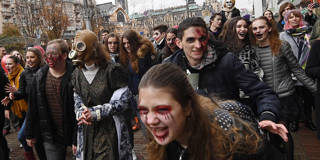OnPoint Subscriber Exclusive
Longer Reads provide in-depth analysis of the ideas and forces shaping politics, economics, international affairs, and more.

Displaying Our Skeletons
Between a plague, a war, and the potential for nuclear Armageddon in Ukraine, one might wonder why public enthusiasm for scary movies and creepy decorations remains strong. How has a holiday rooted in pre-modern agrarian rituals survived in postindustrial society, and why has it spread worldwide?
ATLANTA – What explains the global popularity of Halloween nowadays? In country after country to which Halloween festivities have spread, one is tempted to read politics into it. In the United States, for example, some see in Halloween an expression of countercultural aesthetics representing opposition to capitalist exploitation, gender and racial inequality, and American imperialism.